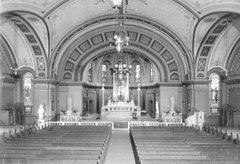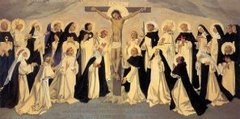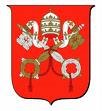How to Paint a Homily, with the Brush of Luke, Evangelist and Painter
A book by Timothy Verdon comments on the readings for the Mass with the masterpieces of Christian art. It is a "preaching through images" that blossomed for centuries in the Church. And the current pontificate wants to revive it
by Sandro Magister
ROMA, November 20, 2007 – Next Sunday, the feast of Christ the King, brings the liturgical year to its conclusion. And the following Sunday, the first Sunday of Advent according to the Roman Rite, begins the new year: the first in the three-year cycle of readings from the Old and New Testament, with pride of place given to the Gospel of Matthew.
The widespread practice among parish priests is to prepare the homilies with the help of books of commentary on the readings of that day's Mass. There are many of these manuals for sale. But that's not how it was long ago.
From the sixth century on, the lectionaries that collected the Gospel and Epistle readings for the Mass did not need any separate commentaries. They were, in themselves, an illustration of the pages of the Sacred Scriptures, a visual guide to understanding them.
These lectionaries explained the Scriptures with images that were placed alongside the texts – for example, the splendid miniatures of the medieval codices. These images served as guides and commentaries for a clergy and a people already accustomed to seeing the events and personalities of the Sacred Scriptures depicted upon the walls of their churches.
And now, just before the first Sunday of Advent, a book has been published in Italy that gives new life to this tradition. It is a commentary on the lectionary of the Sunday and feast day Masses of year A – the volumes for years B and C will follow – made up of images from great Christian art. Images more eloquent than many words.
The author is Timothy Verdon, a priest and art historian, professor at Stanford University and the director of Florence's diocesan office for catechesis through art. He is also the author of important books on Christian art and on the role of art in the Church's life.
The idea of this book came to Verdon from the synod of bishops on the Eucharist in 2005, at which he participated as an expert consultant, at the invitation of Benedict XVI.
In the post-synodal exhortation "Sacramentum Caritatis," pope Joseph Ratzinger dedicated one paragraph, number 41, to religious iconography, which, he writes, "should be directed to sacramental mystagogy," toward initiation into the Christian mystery through the liturgy.
The book is a direct response to this summons. For every Sunday and feast day of the liturgical year, Verdon selects a masterpiece of Christian art related to the Gospel of the day. It is art as the guide to entry within the mystery that is proclaimed and celebrated.
To present this book to the public in Florence just a few days ago, Verdon enlisted a priest who is in complete agreement with this approach: theologian Massimo Naro, the rector of the seminary of the diocese of Caltanissetta and the younger brother of Cataldo Naro, bishop of Monreale until his untimely death one year ago.
The cathedral of Monreale, in Sicily, with its interior completely covered with twelfth century mosaics, is an absolute masterpiece of Christian art. The Christ Pantokrator reproduced above dominates the apse.
But Christian art lives within the liturgy, and for the liturgy. And its language is visual inspection, contemplation. This is what the Italian-German theologian Romano Guardini, one of the current pope's great mentors, understood in visiting the cathedral of Monreale during Holy Week of 1929.
Guardini wrote an account of this visit. Observing the men and women crowding the cathedral of Monreale and participating in the Easter liturgy, he wrote:
"All were living in the gaze [original German: Alle lebten im Blick], all were rapt in contemplation."
Bishop Cataldo Naro reproduced the entire page of Guardini's account in his last pastoral letter to the faithful, to guide them to contemplate and love the Church.
And his brother Massimo cited it again while presenting Verdon's book to the public, in this section of his remarks:
"One must not only believe, confess, profess; one must also 'look upon' the faith. Jesus is the one who has 'seen and heard' his Father. In him is the union of word and image; he is Logos and Eikon (cf. Colossians 1:15). It is no accident that, since the fourth or fifth century, the legend grew in the ancient Church that the evangelist Luke had also been a painter. To this legend may be added the anathema of the second council of Nicaea, according to which 'If anyone does not accept the artistic representation of scenes from the Gospel, let him be excommunicated.' Painting the face of Christ, of Mary, of the saints is another way of writing the Gospel, and thus also of passing it on, proclaiming it, permitting it to be read, meditated upon, and understood by the faithful. In Nicaea, in 787, Church teaching incorporated the legend and gave it the dignity of doctrine, including within the deposit of tradition not only written and oral tradition, but artistic tradition as well; not only the writings of the Old and New Testament and the books of the Church Fathers, but also the images that translate into full color the black ink of the sacred writers."
The works of art selected by Verdon to illustrate the Mass readings of year A are found in churches and museums all over the world. Many of them are in Italy, and a few in Florence, so Florentine priests have a special incentive to make use of this commentary.
But the important thing is the method, which is valid for everyone. Verdon's book teaches an "artistic" interpretation of the biblical texts used in the liturgy. It restores to priests and faithful the fruits of a "preaching through images" developed in the Church over a millennium and a half, and today in danger of withering away.
Because there is an unbreakable bond among Christian art, theology, and liturgy. Just as the cross and the resurrection are the foundation for the composition of the Gospels and the New Testament, and just as Easter is the keystone of the entire liturgical year, so also the Crucified and Risen Jesus is at the genesis of Christian art.
In presenting Verdon's book, Massimo Naro said that he had come to understand "the centrality of the resurrection in Christian art" precisely by examining the mosaics of the cathedral of Monreale, where his brother was the bishop. And here's how he explained this:
"I became convinced of this when I saw, at the top of the arch across from the vault of the main apse where Christ Pantokrator is depicted, the mosaic design of the Mandylion, placed in symmetrical correspondence with the face of the Pantokrator, as if to say that the splendid and glorious Pantokrator is the development of a 'negative' of the face of the Crucified Christ.
"The Mandylion, according to ancient legends going back to the eighth and ninth centuries, was a cloth imprinted with an image of the face of Jesus, bloodied by the blows inflicted upon him during his passion.
"According to some, the Mandylion was the napkin that Veronica used to wipe his face along the road to Calvary (cf. Luke 23:27-28).
"According to others, it was the sudarium that Peter spotted inside the empty tomb on the morning of Easter (cf. John 20:7).
"In that case, this image of Jesus would be one 'not made by human hands,' but rather through divine intervention: the imprinting upon the sudarium of the face of Christ, who in the light of Easter stands again as the Risen One.
"This image of light is, therefore, according to the legend of the Mandylion, the true icon of Christ, the archetype of every image and every work of Christian art.
"In this perspective, it is the light of the resurrection that makes it possible to depict the Crucified Christ of Golgotha, and, in Him, God himself. Only in the light of the resurrection does He who was violently deprived of all human resemblance remain forever as the true and unique image of God.
"It is in this sense that the resurrection stands at the beginning of iconography and Christian art. No distinctively Christian work of art can, therefore, ignore the essential event that transformed creation and redeemed history."
____________
You will find the complete account of Romano Guardini's visit to Monreale, at Easter of 1929, in this article from www.chiesa:
> “Holy Week at Monreale,” the Author: Romano Guardini (12.4.2006)
____________
The book presented on this page, which is planned for translation into other languages:
Timothy Verdon, "La bellezza nella parola. L'arte a commento delle letture festive. Anno A", Edizioni San Paolo, Cinisello Balsamo, 2007, pp. 378, euro 43,00.
__________
Almost at the very same time, a book of art was published in Italy as commentary, not on the readings of the Mass, but on the articles of the Creed. The volume has a preface by Timothy Verdon and an afterword by Ryszard Knapinski. The author teaches at the "Veritatis Splendor" theological institute in Bologna, and is the secretary of cardinal Giacomo Biffi:
Roberto Mastacchi, "Il Credo nell'arte cristiana italiana", Cantagalli, Siena, 2007, pp. 208, euro 23,00.
Wednesday, November 21, 2007
Why what is represented in art matters
I'm reproducing whole an article from Sandro Magister. I do so for the reason, that in the post yesterday, which compares heretical art with a photo, there is a profound reason for rejecting the former in favor of the latter. Even the heretics seem to know this quite well.
Subscribe to:
Post Comments (Atom)





















No comments:
Post a Comment